Discover a suitable-for-holiday-card scene of a gorgeous Christmas tree embroidered with ornaments and powdered with snow. Passersby seem genuinely amused by the appearance of all this white stuff—which is only natural. After all, it’s rare that a snowfall of this magnitude occurs at Disneyland Paris, where the picture was taken in December 2010. More than four inches of snow fell that day, blanketing the entire region and even closing the Eiffel Tower. But for these holiday revelers, the blanket of snow—like an unexpected gift—was a perfect holiday surprise.
Holiday High Notes
On Friday, September 18, 2015, a volunteer group of 75 dedicated members of the Disney Employee Choir had the chance to partake in a unique (and rare) opportunity—to record new show music for the annual Disneyland Candlelight Processional and Ceremony (the event that they perform in annually).
After trekking to the 20th Century Fox Studio lot in Century City, the choir convened at the the historic Newman Scoring Stage (named, in part, after legendary film composer, Alfred Newman), where under the direction of Candlelight conductor Nancy Sulahian, and longtime Disney Entertainment music director and producer Bruce Healey, they recorded new renditions of classic carols for the show’s opening processional.
The choir can now say they have the distinction of having professionally recorded where such recent Disney classics as Pirates of the Caribbean: The Curse of the Black Pearl (2003), Bolt (2008), WALL•E (2008) and Saving Mr. Banks (2013) also laid down their scores. Historic company, indeed!
The newly recorded music debuted with this year’s installment of the Candlelight show. Choir members and their colleagues are honored to know that their collaborative spirit, in the form of beautiful holiday carols, will continue to live on in Walt’s original Magic Kingdom, hopefully for years to come.
Happy D23 Days of Christmas!
In appreciation of all our D23 Members and fans, we have one last video to share with you! From all of us to all of you, thank you for spending this special time of year with us. Happy D23 Days of Christmas!
Christmas Candy Cane Heart Pops
This year, instead of thanking Santa with milk and cookies, why not make him some peppermint candy cane pops? Be sure to make a few extra batches for the reindeer—all are sure to love this easy, no-bake treat!
Ingredients
- 1 ¼ cup crushed mini candy canes, divided
- 2 pounds white chocolate chips
- Optional: peppermint extract
Special Materials
- 4-inch lollipop sticks
Directions
- Place candy canes in a re-sealable sandwich bag, and crush into quarter-inch chunks. Set aside.
- Lay wax paper on a cookie sheet then arrange on the wax paper two mini candy canes in the shape of a heart. Position lollipop stick between the two halves of the heart so that the stick runs through the entire heart right down the middle. Lay out as many hearts as you’d like. Set aside.
- Melt white chocolate chips in a double boiler. Once chocolate is melted, pour 1 cup of the candy cane chunks into the chocolate. Optional: add a few drops of peppermint extract if desired.
- With a teaspoon, slowly spoon melted chocolate between the two halves of the candy cane hearts, making sure to completely cover the lollipop stick within the heart. Even out the surface as much as possible.
- Top each lollipop with the remaining crushed candy canes.
Place cookie sheet in the refrigerator for about 30 minutes or until lollipops firm up. Remove from cookie sheet, wrap each pop in cellophane, and leave a few out for Santa and his reindeer!
Create Santa Cookie Placemat, Cup, and Coaster Decorations
Can you believe it’s our last D23 Days of Christmas day? Thank you so much for spending some time with us this holiday season. As our final craft, we’re helping get you ready for the yearly visit from the big guy himself: Santa Claus!
With this vintage-inspired Santa Cookie Placemat, Cup, and Coaster—designed by D23 and featuring Tinker Bell, Mickey Mouse, and Pluto—Santa will feel right at home… before he has to dash off to his next stop, of course.
Happy Holidays from all of us at D23: The Official Disney Fan Club!
Supplies:
8.5 x 11-inch white cardstock (printable)
Scissors
Tape or glue stick
Medium-size cup or glass
- Download and print out your Santa Cookie Placemat, Cup, and Coaster sheets (Pages 1 and 2) onto your cardstock.
- Using scissors, cut along each image’s black outline.
- Display your placemat where you’re planning to leave out Santa’s milk and cookies (and some carrots for the reindeer, if you’re feeling especially festive).
- Wrap the cup decoration (from Page 2) around your cup or glass. If it’s not too big, apply glue to the shorter tab (marked by a dotted line) on the left-hand side, and close the two ends at the back of the cup—affixing them together to form a sleeve. (If the decoration is a little too long, feel free to trim to size.)
- When the big night comes, set your tray of cookies on top of the placemat (you could even use the Mad Hatter Top Hat Cookie Tray from Day 22!) and set the cup of milk, with its sleeve, on top of the round coaster from Page 2.
- Lie in bed and listen for the clatter of reindeer hooves…
Lightspeed to Box Office History—Plus More in News Briefs
Star Wars: The Force Awakens Breaks Records!
The Force is ridiculously strong with this one… and we’re not surprised! Star Wars: The Force Awakens set a new all-time domestic debut record this weekend with an estimated $248 million—and with a five-day international debut of $281 million, the film has taken in a whopping $529 million globally!
Among the records shattered by Episode VII are: The biggest opening weekend of all time in the United Kingdom (four-day weekend) Australia, Russia, Germany, Sweden, Norway, Finland, Austria, Poland (three-day weekend), Denmark (five-day weekend), Romania, Hungary, Bulgaria, Croatia, Ukraine, Iceland, Serbia, and New Zealand; the biggest IMAX global debut; the biggest December debut; the biggest Thursday night preview gross; the biggest Friday gross; and the fastest film to $100 million and $200 million!
But it’s not just a success financially; the film has garnered an amazing 95 percent Fresh score on Rotten Tomatoes. Talk about an “awakening”… have you felt it yet?
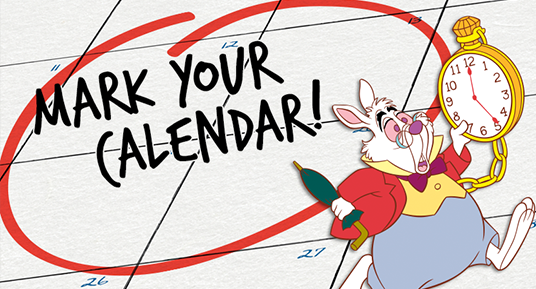
Save the Date!
Be sure to mark these upcoming Disney events on your calendar:
| D23 and Walt Disney Archives January 29 D23 Behind-the-Scenes Experience: Walt Disney’s Office Suite April 20 D23 Member Night at Newsies—On Tour in Portland, Oregon June 8 D23 Member Night at Newsies—On Tour in Salt Lake City, Utah Studios January 29 The Finest Hours opens in theaters. March 4 Zootopia opens in theaters. April 15 The Jungle Book opens in theaters. May 6 Captain America: Civil War opens in theaters. May 27 Alice Through the Looking Glass opens in theaters. |
Parks January 16 Club Villain at Disney’s Hollywood Studios March 2—May 30, 2016 Epcot International Flower & Garden Festival Television December 25 32nd Annual Disney Parks Christmas Day Parade airs at 10 a.m. ET on ABC January 15 The Lion Guard series premieres on Disney Channel at 9:30 a.m. ET/PT January 19 Marvel’s Agent Carter returns to ABC at 9 p.m. ET |
New Poster For 2016’s The Jungle Book
Chances are you saw the very cool trailer for 2016’s The Jungle Book before launching into the Star Wars galaxy at a cineplex near you this past weekend. Now take a gander at the film’s brand-new “living” poster! Directed by Jon Favreau (Iron Man), based on Rudyard Kipling’s timeless stories, and inspired by Disney’s classic animated film, The Jungle Book is an all-new live-action epic adventure about Mowgli (newcomer Neel Sethi), a man-cub who’s been raised by a family of wolves. But Mowgli finds he’s no longer welcome in the jungle when fearsome tiger Shere Khan (voice of Idris Elba)—who bears the scars of Man—promises to eliminate what he sees as a threat. Urged to abandon the only home he’s ever known, Mowgli embarks on a journey of self-discovery, guided by panther-turned-mentor Bagheera (voice of Ben Kingsley) and free-spirited bear Baloo (voice of Bill Murray). Along the way, Mowgli encounters jungle creatures that don’t exactly have his best interests at heart—including hypnotizing python Kaa (voice of Scarlett Johansson) and smooth-talking King Louie (voice of Christopher Walken). Look for The Jungle Book to swing into theatres on April 15, 2016!
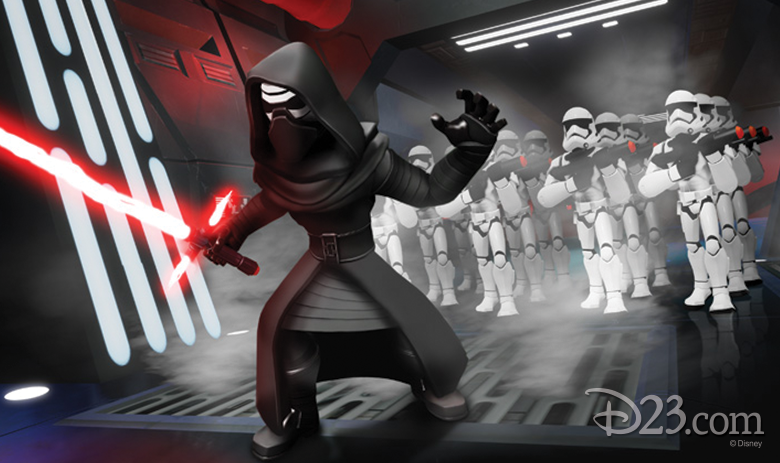
The Force Awakens for Disney Infinity 3.0 Edition
On the same day as its film counterpart’s big debut, Disney Interactive and Lucasfilm launched their huge Star Wars: The Force Awakens Play Set, the third Star Wars Play Set for Disney Infinity 3.0 Edition—which gives fans the opportunity to play with Finn, Rey, Kylo Ren, and Poe Dameron in the latest chapter of the Star Wars saga!
In addition to the characters native to Star Wars: The Force Awakens Play Set, players will be able to unlock and use all Star Wars characters from Star Wars: Twilight of the Republic and Star Wars: Rise Against The Empire, as well as from Star Wars Rebels’ universe.
Now, if you’ll excuse us, we’re gonna spend some of our Christmas vacation looking for scrap metal with Rey on Jakku… Happy Holidays!
More Disney Artists Share Their Fandom in Holiday Cards!
On December 3, we presented exclusive artwork created just for D23 Members by Disney artists Dave Pacheco (Disney Consumer Products), Alex Maher (Disney Design Group), and Brian Crosby (Marvel Themed Entertainment). Today, three more artists present holiday cards to share the spirit of the season in unique Disney fashion.
From all of us to all of you, we hope you enjoy the yuletide charm of these special pieces!
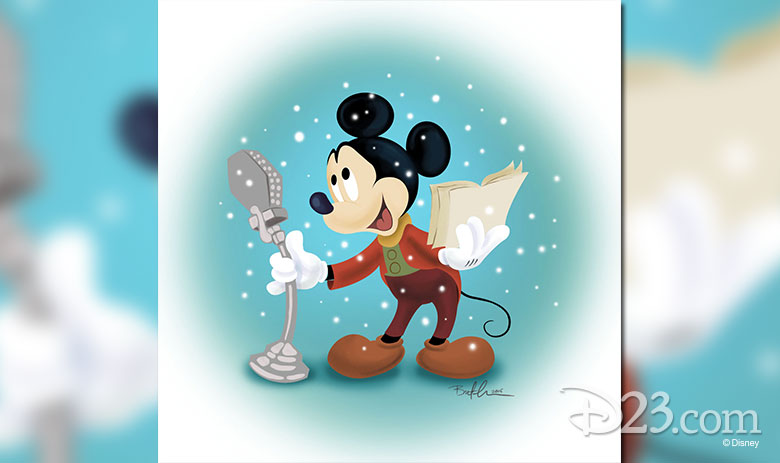
In this piece, artist Bret Iwan, who provides the voice of Mickey Mouse, pays tribute to the legacy of Disney Character Voices and the Academy Award-nominated Mickey’s Christmas Carol (1983). Here, Mickey dons his Bob Cratchit wardrobe to deliver lines from the beloved holiday classic, for which Disney Legend Wayne Allwine, the former and longtime voice of Mickey, performed the role.
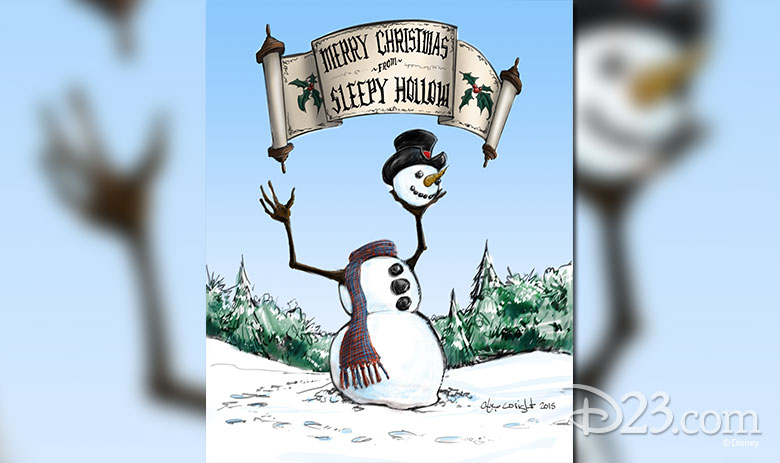
Alex Wright, Creative Director, Walt Disney Imagineering, helps elucidate what goes on at Sleepy Hollow, New York State… When wintry weather spreads ’cross the land, a snowman holds his noggin in his hand! (Let’s just say the snowman seems much friendlier than his Halloween counterpart.)
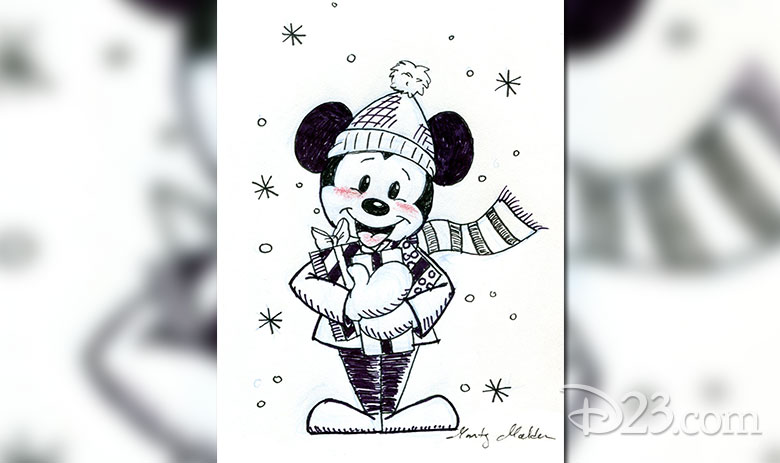
This adorable sketch of Mickey Mouse by Monty Maldovan, Senior Designer, Disney Store, reminds us that Christmas is just around the corner. It looks like Mickey hasn’t forgotten to get gifts for a special friend—perhaps they’re for you!
Oysters Rockefeller
Served on the half shell, these luscious oysters are topped with butter, Parmesan and bread crumbs and baked until golden. A big thanks to our friends at ABC’s The Chew for this delicious recipe.
For more recipes and crafts, visit TheChew.com and tune in WEEKDAYS 1e|12c|p on ABC.
Servings: 6
30 to 60 min
Ingredients
16 large oysters (shucked and chilled in half shell)
3 tablespoons butter
1 small onion (finely chopped)
1 garlic clove (minced)
4 cups fresh spinach
2 teaspoons anise flavored liquor (optional)
½ cup panko bread crumbs
⅓ cup grated parmesan cheese
hot sauce (to taste)
salt
freshly cracked black pepper
rock salt (to line baking sheet)
Step-by-step Directions
- Preheat oven to 400 F. Melt butter in a saute pan over medium. Add the onions and season with salt. Cook for 2 to 3 minutes or until translucent. Add the garlic and cook until fragrant.
- Add the spinach and toss to combine with onions. Drizzle the anise liquor over spinach and cook until wilted.
- Remove pan from heat and stir in bread crumbs, cheese and hot sauce. Adjust seasoning to taste.
- Place a heaping tablespoon of spinach mixture on top of each oyster and arrange on a baking sheet lined with rock salt. Bake for 6 to 8 minutes or until light golden on top. Serve warm with a glass of cold champagne.
Make the Mad Hatter’s Top Hat Cookie Tray
Putting out cookies in advance of Santa Claus’ arrival on Christmas Eve? This wacky cookie tray is just the ticket to bring a little “madness” to Santa’s big night. Make this design your own by either using traditional holiday colors, or any hue that strikes your fancy. (For added Wonderland authenticity, feel free to add the Hatter’s “10/6” price tag.)
Supplies:
Scissors
Drawing compass
Paintbrush
Fabric or craft glue
Cardstock, any light color, about 11-inch by 11-inch
Cylindrical cardboard container, 5½-inch diameter, cut down to 6½-inch height
2-inch-wide ribbon, red (or other color), 18 inches long
Acrylic paint, green (or other color)
- Using the compass, draw a 10-inch-diameter circle on the cardstock. Keeping the point of the compass in the same position on the cardstock, draw a 5½-inch-diameter circle inside the 10-inch circle. Then draw a 4½-inch-diameter circle inside the 5½-inch circle.
- Cut out the 10-inch circle, and then cut the 4½-inch circle out of the center, creating a ring for the hat brim. Make slashes about ½ inch apart all around the inside of the ring, cutting from the inside edge up to the line marking the 5½-inch circle.
- Set the cylindrical container on your worktable with the open end up. Apply glue around the inside of the open end. Put the hat brim on top of the container, and fold the slashed edge down inside the container, pressing the cardstock tabs into the glue. Let the glue dry.
- Paint the outside of the hat and top of the hat brim green (or the color of your choosing). Let the paint dry. Then turn the hat over and paint the underside of the brim. Let the paint dry. If the markings on the cylinder show through the paint, brush on another coat, and let dry.
- Using your hands, roll two opposite sides of the brim towards the top of the hat so the brim curls up a little (as shown in photo).
- Wrap the ribbon around the hat and glue the ribbon ends together.
- When it’s time for Santa to visit your home, place the hat where he’ll be sure to see it! Then place the cookies (or other goodies) around the brim. You can add a small (plastic or paper) cup of milk to the top of the hat, if it’s sturdy enough.
NOTE: Cutting should be done by an adult.
Scintillating Swiss Family Robinson Fun Facts
By Jim Fanning
Anyone who has seen Swiss Family Robinson, which was released on December 21, 1960, danced the “Swisskapolka,” entranced by the lush scenery, heartwarming familial affection, bold heroics and sweeping adventure. Described by Walt Disney himself as “one of the greatest adventure stories of all time,” this widescreen epic tells of the resourceful Robinsons—Mother, Father, and their three sons, Fritz, Ernst, and Francis—who are plunged into the escapade of a lifetime on an uncharted island. “The story starts,” related Walt, “with the most memorable of shipwrecks. Abandoned without hope of rescue, this courageous family was faced with a thousand dangers. In spite of their many difficulties they establish themselves in this new world, and build a fabulous treehouse, domesticate wild animals, and create a happy way of life in their island paradise.” But danger abounds as the brave family employs ingenious “life hacks” to survive severe weather, wild animals and marauding pirates. The behind-the-scenes struggles of the Disney cast and crew to produce this extravagant epic—filmed on location in the West Indies—mirrored the onscreen perils. Here are some colorful facts culled from the logbook of the filmmakers behind the Swiss family
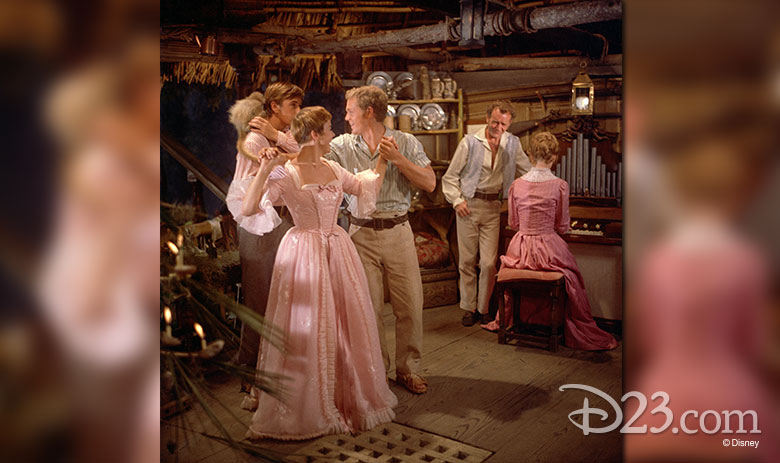
Bringing Swiss to the Screen: An Adventure In Adaptation
Walt had long sought to bring his own version of the famous Swiss Family Robinson book to the screen; at one point he was considering producing the story for the Disney TV show. The book “was written a century a half ago, and countless generations have enjoyed it ever since,” noted Walt. “When we decided to bring this story to the screen, we knew it had the elements to make an exciting motion picture.” Johann Wyss originally wrote The Swiss Family Robinson in 1812 with his four sons as they made up their own Robinson Crusoe adventures. A Swiss minister, Wyss also tasked himself with conveying life lessons about family and self-sufficiency. When Walt was dissatisfied with the first two treatments of the book, producer Bill Anderson came up with the concept of the pirates as an overarching threat. “What we did was more or less throw Wyss’ book away,” revealed Ken Annakin, who helmed the action-adventure. Walt was especially intrigued with all the marvelous fun a family could have on an island. “There are endless possibilities,” he told Ken. “What I’d like you to do is to start thinking of all the things you’d like to happen to that family if it were yours. Think of anything, no matter how crazy!” “We would go in for a conference each day,” said Ken, who was one of Walt’s favorite directors, “and Walt would latch on to something we said and then come up with an idea, which was usually far better than anything any of us had thought of. [He] was very creative, and he did put a very strong stamp on the picture.”
Walt signed accomplished sketch artist John L. Jensen, whose credits included The Ten Commandments (1956) and The Buccaneer (1958), to storyboard Swiss Family Robinson. “Those pictures became the gospel for the filming of the picture,” said Ken.
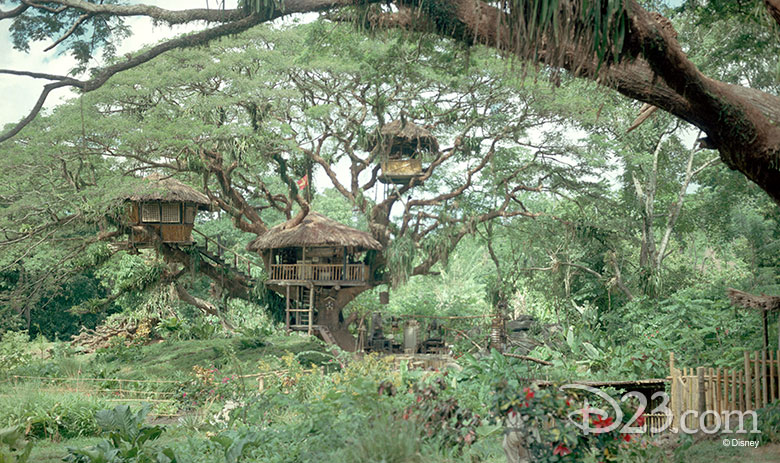
No Movie Set Is An Island (Except in This Case)
“We knew we couldn’t do justice to this story on a Hollywood soundstage, so we began a search to find a tropical island such as described in the book,” Walt Disney said. “Right off the island of Trinidad in the Caribbean sea is the smaller island of Tobago. Tobago had everything we needed. In fact, it’s an island where the adventures of the Swiss Family Robinson could have actually happened.” Producer Bill Anderson recalled the “many meetings with Walt to decide how Swiss Family Robinson was going to be produced. There were two opinions. One was that we would make the picture on the Burbank lot using special process photography.” The second opinion was Walt’s: A soundstage could never do justice to the island exploits he envisioned for the Robinsons. The entire film, Disney decreed, was to be shot on location. How did the Disney team find this little known and unspoiled tropical hideaway? “Our director, Ken Annakin, had worked not only in the Far East but in Africa, and our associate producer, Basil Keys, had also worked on many international productions,” said Bill Anderson. “Keys wanted to film in East Africa and Annakin wanted to go to Ceylon to make it. And I insisted they explore the Caribbean. At first, they were discouraged because most of the islands lay flat, and we needed more divergent terrain. Finally, I received a wire saying they had found this island of Tobago situated at the end of the Leeward Isles in the West Indies. I flew down there and found it scenically beautiful and perfect for our filming needs. Not only that, Tobago was the legendary home of Robinson Crusoe, which tied in perfectly with the storyline of Swiss Family Robinson.” The island had six different beaches, a giant tree for the Robinsons’ famous treehouse, swamps, mountains, and four hotels to house the cast and crew for six months. Most incredible, however, was the natural beauty of the island, undiscovered as yet by tourists. “I’ve been all over the world to shooting locations,” John Mills said years later, “and I don’t think I’ve ever been to a more lovely location.” Tommy Kirk concurred, saying Swiss Family Robinson was his favorite movie memory as it was in filmed in such a beautiful place.
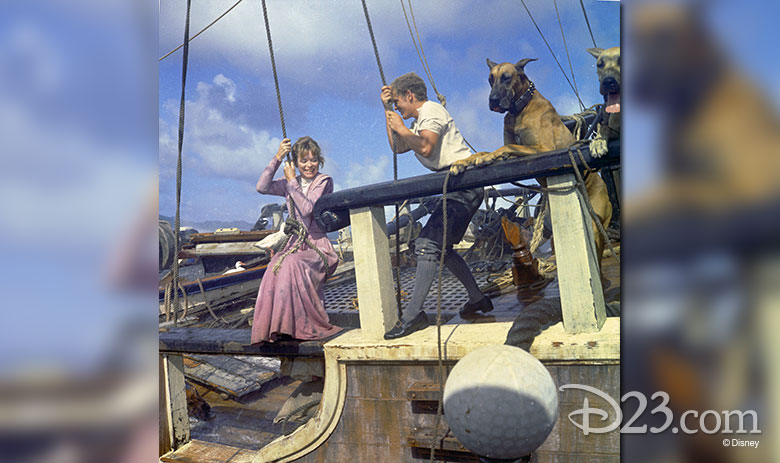
Setting the Swiss Family Scene
The pristine beauty of Tobago came at a price, however. “Since our stage was a tropical island,” said Walt of the remote location, “we knew we would be faced with many problems. But like the Swiss Family Robinson, we improvised, invented, and had a wonderful time doing it.” “Right away,” added Bill Anderson, “it was evident that making a picture there was going to be difficult because of the lack of facilities. We needed a warehouse and a cover stage. Walt realized this was going to be costly but he finally agreed to it. We put all the money into what is seen on the screen but we still had tremendous problems. We had to build our own soundstage out of sheet metal. We had to import everything that was used. It was a tremendous logistical problem.” As thousands of tons of equipment and materials were flown in, as a crew of nearly 1,000 descended on the island to construct roads, storm shelters, cooking and dining facilities, and even the inevitable parking lots. Greenery (including green paint) camouflaged any neighboring buildings. The wreckage of the Robinsons’ ship was built from scratch on one of the island’s reefs. Three months, two sixty-foot towers and the assistance of highly trained divers were required to build the wreck, modeled after Captain Cook’s famous three-master, the Endeavour. Mother Nature provided some of the sets, such as the two-tiered Craig Hall Waterfall, where Father and the boys swing on ropes over this natural water park.
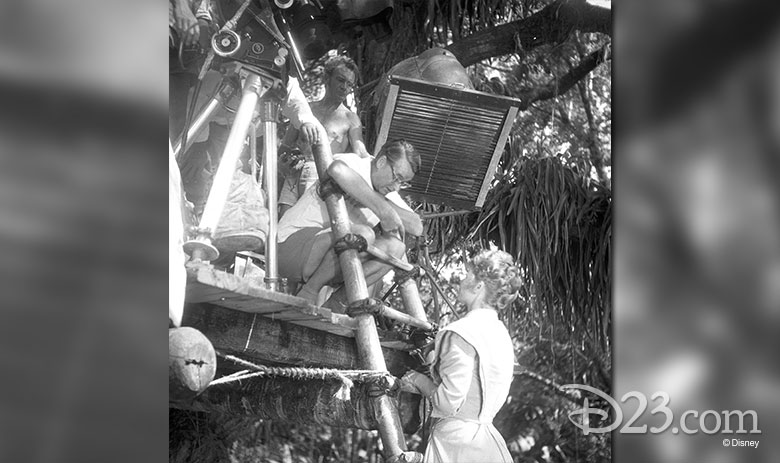
Adventures in Filmmaking
After five months of intense location preparation, the cameras finally rolled on August 17, 1959. “We experienced one of the biggest storms ever to hit the island of Tobago,” said Bill Anderson. “It flooded our stage and flooded out our treehouse and other sets. We couldn’t shoot for weeks. In fact, the crew set to and helped the natives clean up the debris and reconstruct their homes.” The idyllic swimming hole was a difficult shooting site; surrounded by dense foliage, the pool got only three hours of sunlight a day, and it took weeks to film to the fun-filled swimming sequence in it. While shooting James MacArthur’s battle with the 22-foot-long, 250-pound anaconda snake, MacArthur almost drowned and had to be pulled from the swampy waters by crewmembers. Second-unit director, legendary stuntman Yakima Canutt, singlehandedly rescued two stunt doubles trapped by the powerful currents of Tobago’s coral reef. Athletic James MacArthur loved scuba diving and one time encountered a great white shark that, as Tommy Kirk recalled, “wasn’t looking for an autograph.” James also loved to climb the palm trees and especially to dive off the set of the topmost mast of the wrecked ship.
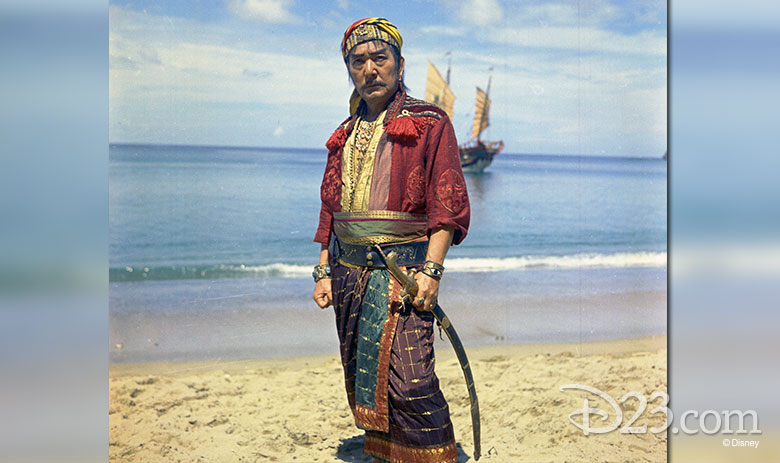
Family and Friends (and Foes)
The cast was filled with Disney faves: James MacArthur (who had just played a Swiss lad in Third Man on the Mountain, 1959), Disney Legends Tommy Kirk and Kevin “Moochie” Corcoran (who had just played brothers in The Shaggy Dog, 1959), Dorothy McGuire (who had played Tommy and Kevin’s mother in Old Yeller, 1957) and Janet Munro (who was James’s love interest in Third Man on the Mountain). Joining this Disney “family” was John Mills. One of Britain’s most distinguished stage actors, John had also shone on the silver screen, in flims ranging from David Lean’s Great Expectations (1946) to War and Peace (1956). Portraying the wicked pirate chief was Best Supporting Actor Oscar® Nominee (for Bridge on the River Kwai, 1957) Sessue Hayakawa. “He arrived from Japan with two very beautiful young women,” noted James MacArthur, “whose entire job was to fan him between shots.”
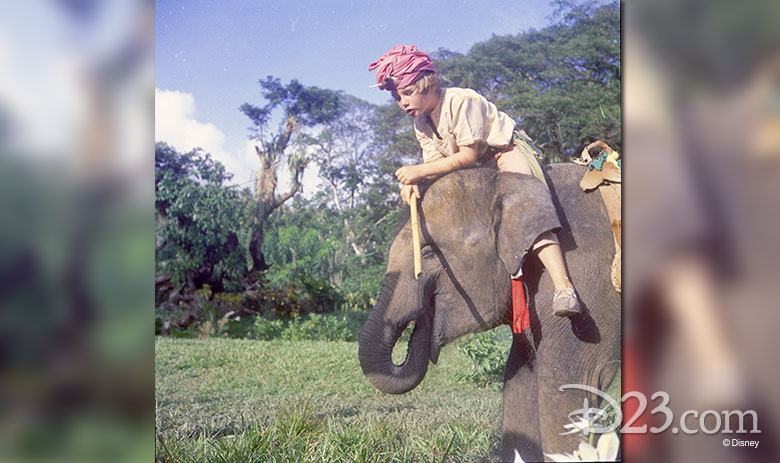
Cast of Critters
To help populate the on-screen island, 500 animals were also shipped in from all over the globe including eight dogs, two giant tortoises, 40 monkeys, two elephants, six ostriches, four zebras, 100 flamingos, six hyenas, two anacondas, and a tiger. These temperamental “stars” caused a few challenges during the lengthy shoot. Filming stopped entirely when the flighty flamingos suddenly migrated south to British Guiana. To the relief of the director, the wayward birds returned the next day at feeding time. One of the animal actors, a 5-year-old elephant named Rocky—so named because she enjoyed having her head rubbed with a rock—almost accidently brought a premature end to Kevin Corcoran’s career when a wave washed Moochie underfoot. Luckily, another wave lifted Rocky off long enough for the young actor to surface. As for the tiger, who Walt was determined to have in the film, it leapt out of the Francis-constructed pit after the trainer had assured everyone it would be impossible for the beast to do just that.
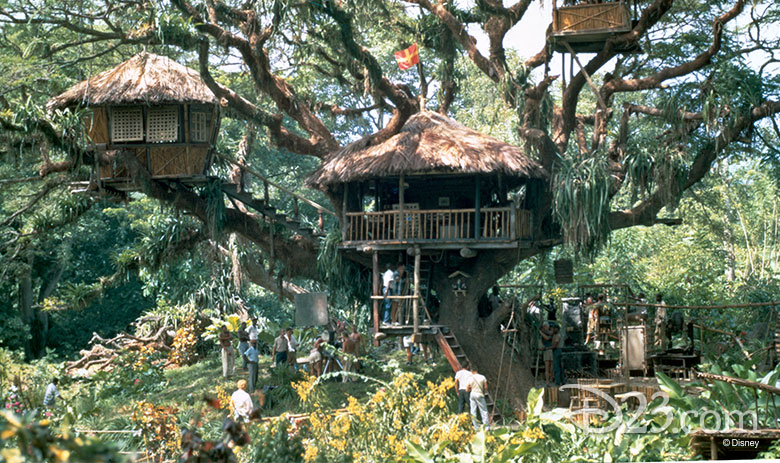
Island Living Reaches New Heights of Luxury
The real “star” of the show was the iconic, triple-deck treehouse. This elaborate treetop dream house was built in the 200-foot spread of a living Samaan tree. Art director John Howell spotted the enormous tree through a fence at the corner of a cricket field just outside the town of Goldsborough. “It was really solid—capable of holding 20 crew and cast and constructed in sections so that it could be taken apart and rebuilt on film by the family,” said Ken Annakin. John Mills’ son, Jonathan, recalled playing for hours in the treehouse. (Also on set for some of the shoot: Jonathan’s sisters Juliette and newly-minted Disney star Hayley, who had just completed Pollyanna, 1960.) The treehouse remained after Swiss Family Robinson wrapped until a hurricane swept the structures away. The Samaan tree itself still survives today, however, a towering reminder of the timeless movie filmed there.
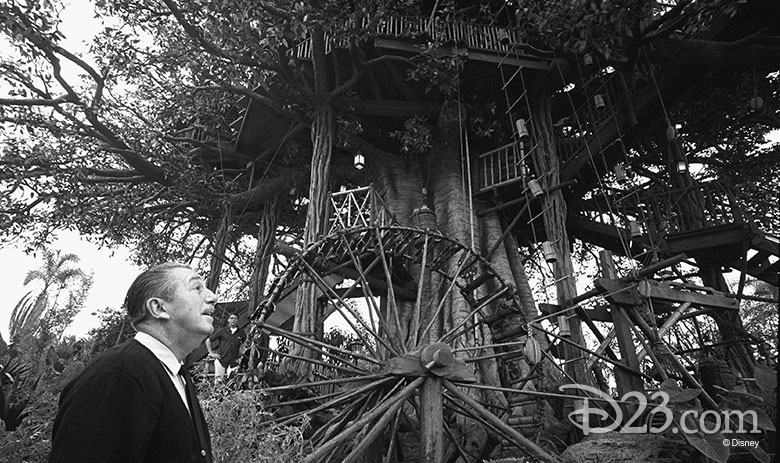
Mind Thy Head
“Every kid has had dreams of living in a treehouse,” said Walt Disney, “and the Swiss Family Robinson Treehouse probably tops those dreams”—but Walt was speaking not of film’s treehouse but its authentic recreation at Disneyland Park. Imagineers studied the gnarled roots of the mammoth Moreton Bay Fig Tree planted in the 1800s by Anaheim horticulturist Tim Carroll to aid in authentically creating details of the Disneyland tree, including knots and the massive root system at ground level. When the attraction opened on November 18, 1962, John Mills, his wife, Mary, and daughter Hayley were at the dedication with Walt, as was Kevin Corcoran and the Swiss consulate, who presented Walt with a Swiss flag that then flew from the top of the treehouse. Known as a Disneyodendron semperflorens grandis (large ever-blooming Disney tree), the 70-foot-tall and 80-foot-wide man-made tree has concrete roots and steel limbs, covered in concrete, with 300,000 hand-attached plastic leaves. Though the famed Adventureland fixture was transformed in 1999 into Tarzan’s Treehouse, there’s a Swiss Family Treehouse in Magic Kingdom Park at Walt Disney World Resort and also at Tokyo Disneyland. In Disneyland Park in Disneyland Paris, the attraction, known as La Cabane des Robinson, is located on the north side of Adventure Isle in Adventureland.
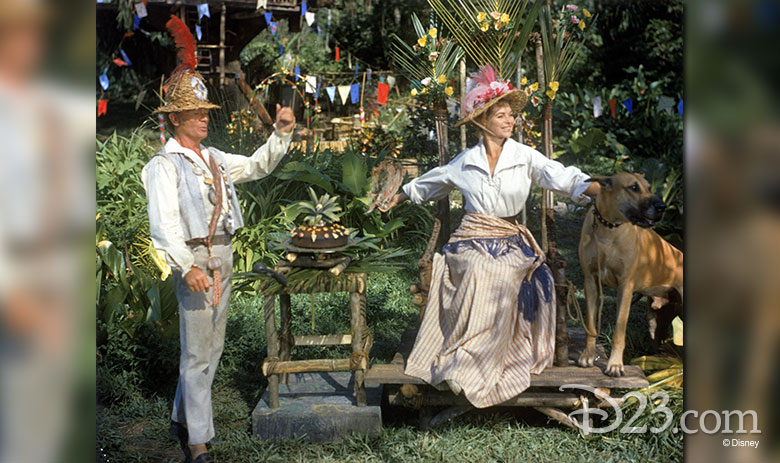
They Turned a Lost Island Into an Exotic Paradise!
The complex location filming resulted in a six-month shoot that went several weeks overschedule. Another glitch arose post-production when the sound was found to be unusable and the entire principal cast had to be regrouped in England for 28 days of re-recording every single word of dialog heard in the film. Filmed in breathtaking widescreen Panavision®, Swiss Family Robinson was the most expensive Disney movie ever filmed up until that time, but as Walt said, “Such a great story as the Swiss Family Robinson deserves every penny we spent on it.” Audiences agreed, making Swiss Family Robinson one of the most popular films Walt Disney ever produced. Audiences continue to be swept away into high adventure—and an even higher treehouse—in this unforgettable Disney live-action classic.


